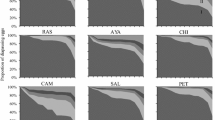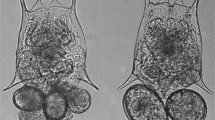Abstract
A comparative study was carried out on the seasonal variation in egg and body volumes of four species of rotifers, Brachionus calyciflorus, Brachionus angularis, Keratella quadrata and Anuraeopsis fissa, from ponds near Sevilla and in Doñana National Park. Temperature and food concentration significantly affected egg volume in all four species; clutch size significantly affected egg volume in A. fissa, B. calyciflorus and B. angularis, but not in K. quadrata. As temperature increased, egg and body volumes declined in A. fissa and B. angularis but increased in K. quadrata and B. calyciflorus due, perhaps, to complex interactions between temperature, food level and clutch size.
All four rotifer species responded similarly to changes in food concentration: below a certain food level, egg and body volumes were small but increased to a maximal size, which differed in the four species, as the food concentration was raised. At higher food levels, there was a reduction in egg and body volumes. The food levels for maximum egg and body volumes are interpreted as optimal ones; below these, food limitation reduces the size of the reproducing adult and, consequently, the size of eggs. Above this optimal level, higher food levels accelerated the rotifer life cycles, resulting in adults maturing at smaller sizes with a larger number of smaller eggs.
Similar content being viewed by others
References
Amren, H., 1964. Ecological studies of zooplankton populations in some ponds on Spitsbergen. Zool. Bidr. Uppsala 36: 162–191.
Bennett, W. N. & M. E. Boraas, 1989. A demographic profile of the fastest growing metazoan: a strain of Brachionus calyciflorus (Rotifera). Oikos 55: 365–369.
Gilbert, J. J. & K. G. Bogdan, 1984. Rotifer grazing: In situ studies on selectivity and rates. Trophic interactions Within Aquatic ecosystems, D. G. Meyers & J. R. Strickler (eds): 97–133. AAAS Selected Symposium 85.
Guisande, C. & L. Serrano, 1989. Analysis of protein carbohydrate and lipid in rotifers. In C. Ricci, T. W. Snell & C. E. King, editors. Rotifer Symposium V. In C. Ricci, T. W. Snell & C. E. King (eds), Rotifer Symposium V. Developments in Hydrobiology 52. Kluwer Academic Publishers, Dordrecht: 339–346. Reprinted from Hydrobiologia 186/187.
Guisande, C. & N. Mazuelos, 1991. Reproductive pattern of Brachionus calyciflorus Pallas at different food concentrations. J. Plankton. Res. 13: 279–286.
Halbach, U. & G. Halbach-Keup, 1974. Quantitative Beziehungen zwischen Phytoplankton und der Populationsdynamik des Rotators Brachionus calyciflorus Pallas. Befunde aus Laboratoriums-experimenten und Freilanduntersuchungen. Arch. für Hydrobiol. 73: 273–309.
Lowry, O. H., N. J. Rosenbraugh, A. L. Farr & R. J. Randall, 1951. Protein measurements with the Folin phenol reagent. J. Biol. Chem. 193: 256–275.
Markwell, M. A. K., S. M. Haas, L. L. Bieber & N. E. Tolbert, 1978. A modification of the Lowry procedure to simplify protein determination in membrane and lipoprotein samples. Analyt. Biochem. 87: 206–210.
Pilarska, J., 1977. Eco-physiological studies on Brachionus rubens EHRBG (Rotatoria) II. Production and respiration. Pol. Arch. Hybrobiol. 24: 329–341.
Pourriot, R., 1973. Rapports entre température, la taille des adultes, la longueur des oeufs et le taux de développement embryonaire chez Brachionus calyciflorus PALLAS (Rotifère). Ann. Hydrobiol. 1: 171–178.
Robertson, J. R. & G. W. Salt, 1981. Responses in growth, mortality, and reproduction to variable food levels by the rotifer, Asplanchna girodi. Ecology 62: 1585–1596.
Rothaupt, K. O., 1990. Differences in particle size-dependent feeding efficiencies of closely related rotifer species. Limnol. Oceanogr. 35: 16–23.
Ruttner-Kolisko, A., 1977. Suggestions for biomass calculation of plankton rotifers. Arch. Hydrobiol. Beih. 8: 71–76.
Sarma, S. S. S. & T. R. Rao, 1987. Effect of food level on body size and egg size in growing population of the rotifer Brachionus patulus Muller. Arch. Hydrobiol. 111: 245–254.
Sokal, R. R. & F. J. Rohlf, 1981. Biometry. Freeman, San Francisco.
Statgraphic, 1985. STSC Users' Guide. Software Publishing Group Rockville.
Stemberger, R. S. & J. J. Gilbert, 1985. Body size, food concentration, and population growth in planktonic rotifers. Ecology 66: 1151–1159.
Walz, N., 1983. Continuous culture of the pelagic rotifers Keratella cochlearis and Brachionus angularis. Arch. Hydrobiol. 98: 70–92.
Walz, N., 1987. Comparative population dynamics of the rotifers Brachionus angularis and Keratella cochlearis. In L. May, R. Wallace & A. Herzig (eds), Rotifer Symposium IV. Developments in Hydrobiology 42. Dr W. Junk Publishers, Dordrecht: 209–213. Reprinted from Hydrobiologia 147.
Author information
Authors and Affiliations
Rights and permissions
About this article
Cite this article
Galindo, M.D., Guisande, C. & Toja, J. Reproductive investment of several rotifer species. Hydrobiologia 255, 317–324 (1993). https://doi.org/10.1007/BF00025854
Issue Date:
DOI: https://doi.org/10.1007/BF00025854




